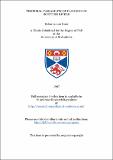Files in this item
Temporal variability of flooding in Scottish rivers
Item metadata
| dc.contributor.advisor | Werritty, Alan | |
| dc.contributor.advisor | Black, Andrew Roger | |
| dc.contributor.author | Grew, Helen Louise | |
| dc.coverage.spatial | 415 p. | en_US |
| dc.date.accessioned | 2018-07-10T15:21:39Z | |
| dc.date.available | 2018-07-10T15:21:39Z | |
| dc.date.issued | 1997 | |
| dc.identifier.uri | https://hdl.handle.net/10023/15203 | |
| dc.description.abstract | Over fifty peaks-over-threshold flood records from across Scotland are analysed for temporal and spatial variability over two standard periods, 1954-92 and 1964-1992, using a number of time series statistical techniques. The results of this analysis demonstrate both clear temporal and spatial patterns in the frequency and magnitude of floods. The period 1964-73 is characterised by decreasing flood frequencies, with the early 1970s standing out as being "flood poor", particularly in the eastern regions of Scotland, whilst the 1950s and more recently, the late 1980s and early 1990s can be characterised as "flood rich". A broadly similar pattern is evident in many flood magnitude series. The influence of climatic variability upon flood records is also examined over the same periods of time, using a regional synoptic classification of daily weather types. The Westerly, Cyclonic and South-Westerly weather types are identified as important mechanisms in initiating Scottish flood events. These weather types also show a strong link with catchment location, with the Westerly type being important in the more westerly catchments, the South-Westerly type being important in the south-west and west whilst flood events in the more eastern catchments are often associated with the incidence of the Cyclonic weather type. The annual frequencies of these three key weather types also show clear patterns of temporal variability. However, a seasonal split of weather type frequencies also reveals some contrasting seasonal trends which are masked within the amalgamated annual series. The most dramatic variability is evident within the time series of the South-Westerly weather type, where frequencies have been increasing steadily since the mid 1970s in all seasons. Recent increases in the incidence of the most frequently occurring weather type - the Westerly - appear to be confined to the winter months (December to February). The relationship between temporal variability within flood series and the climate are tentatively explored through a simple comparison exercise using the two sets of time series plots, linked by information obtained on trigger weather types and dominant seasons of flooding. This process suggests that the relationship between flood series and the climate is a complex one which cannot be adequately explained using the results of this research. More likely other factors, such as precipitation variability, need to be introduced into the equation before a more complete picture is acquired. The possible consequences of the variability detected within flood series are highlighted with reference to flood frequency analysis, a technique which makes the assumption that flood records, and ultimately climatic records, are stationary through time. By splitting individual flood records into hydrologically similar sub-periods, it is revealed that frequency-magnitude relationships may vary considerably, depending upon the period of record used. It is recommended that, in future, hydrologists consider splitting flood series (into hydrologically similar sub-periods or in terms of the weather types linked to each flood) in order to examine the range of frequency-magnitude relationships which exist. | en_US |
| dc.language.iso | en | en_US |
| dc.publisher | University of St Andrews | |
| dc.subject.lcc | GB568.S3G8 | en |
| dc.subject.lcsh | Rivers Scotland | en |
| dc.title | Temporal variability of flooding in Scottish rivers | en_US |
| dc.type | Thesis | en_US |
| dc.contributor.sponsor | Natural Environment Research Council (NERC) | en_US |
| dc.type.qualificationlevel | Doctoral | en_US |
| dc.type.qualificationname | PhD Doctor of Philosophy | en_US |
| dc.publisher.institution | The University of St Andrews | en_US |
This item appears in the following Collection(s)
Items in the St Andrews Research Repository are protected by copyright, with all rights reserved, unless otherwise indicated.

